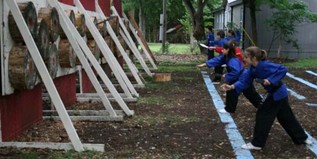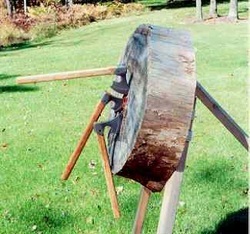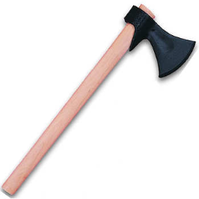Tomahawk Throwing Competitions
Participating in tomahawk throwing events and other competitions is an enjoyable and exciting pastime that dates back to the Colonial Period. It has endured throughout the ages and players have developed a set of rules and challenges to make the most out of this sport. This article will tell you everything you need to know about organizing a tomahawk throwing competition.
Throwing Range

Since tomahawk throwing deals with a potentially dangerous weapon, the throwing area must be kept safe. There should be a minimum distance of 50 feet behind the target to ensure that spectator's won't just walk in to the area. The target area should be taped off using flags or light fencing materials. There should also be a first aid kit as well people trained in First Aid and CPR, in the event of an emergency. For competition in rural and remote areas, the GPS location for the event should be reported just in case First-Responders are needed in the location.
Target Types

Targets can be made from sections of tree trunks or planks of lumber or soft wood. The diameter should be at least 12" and a thickness of 4". The bull's eye for the target should be 3" in diameter with outer circle concentric rings spaced every 2". You can paint directly on the target board or you can attach a bull's eye target. The boards should also be spaced at least 10 feet apart to prevent thrower's from hitting the neighboring target. It is also recommended to prepare extra target boards, just in case some will be destroyed during the competition.
See other target options for your tomahawk throwing!
Safety Throwing Line
The throw line is the area where the participants will throw their tomahawks at the target. To make it visible, it can be marked by either a spray paint for outdoor sporting fields or a long length or rope can be placed on the ground. If a participant will step over the throw line, he/she may be penalized. A throw line can be static or mobile. Static throw line refers to tomahawks thrown from the same distance. A mobile throw line, on the other hand, allows the movement of participants to other fixed points away from the target. This means that they can throw from 10 feet, then move back to 15 feet, 20 feet, and so on. The throw lines should be marked before the start of the competition.
Scoring the Competition
Scores are dependent on the number of tomahawks thrown and where it strikes the target. Each position on the target is assigned an arbitrary number as well as the actual target struck in sequence. If a hawk strikes a target out of sequence, it can cost the thrower a point. Multiple hits on a single target when more than one is used is considered a miss. An example for this is a single thrower with a target position holding 5 targets, with two on the left,one in the center and two on the right.
The thrower is usually instructed to hit the targets in a particular sequence. For example, top left, bottom left, center, bottom right and top right. If the thrower doesn't follow the order, then it's considered as a miss. A hit on the bull's eye is scored as 5 points, the ring next to it is given 4 and 3 for the outermost ring. If it doesn't hit any of the rings but still hits the target, it's given 1 point. If ever the hawk lands on a ring between 2 values, the score should be for higher value. The scores can be increased by a point if the distance will also increase.
The thrower is usually instructed to hit the targets in a particular sequence. For example, top left, bottom left, center, bottom right and top right. If the thrower doesn't follow the order, then it's considered as a miss. A hit on the bull's eye is scored as 5 points, the ring next to it is given 4 and 3 for the outermost ring. If it doesn't hit any of the rings but still hits the target, it's given 1 point. If ever the hawk lands on a ring between 2 values, the score should be for higher value. The scores can be increased by a point if the distance will also increase.
Tomahawks for Competition

The best tomahawk to use for competition should have the following characteristics:
For more information on how to select the best tomahawk you can click here.
- Minimum handle length of 12” and not exceeding 24”
- Maximum cutting edge of 4.5”
- An unsharpened edge for safety. blade geometry and force of the throw is what makes the hawk stick to the target
For more information on how to select the best tomahawk you can click here.

